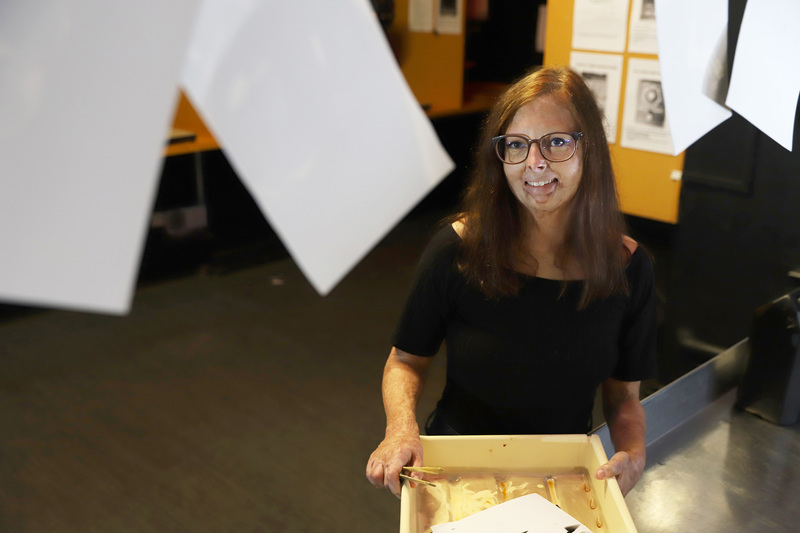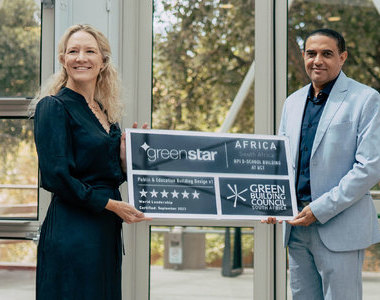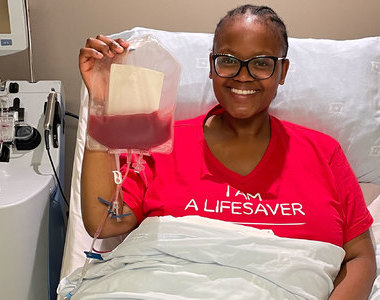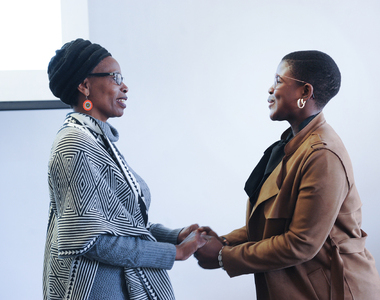‘Imposter’ graduates with full suite of distinctions
04 April 2019 | Story Niémah Davids. Photo Michael Hammond. Read time 7 min.
Despite 50 surgical procedures, burn wounds to 95% of her body and being given only a 20% chance of survival after a gas explosion 15 years ago, Aniek Nieuwenhuis has defied the odds and will join hundreds of University of Cape Town (UCT) graduates as they are capped this month.
Nieuwenhuis, a fine art student at the Michaelis School of Fine Art in the Faculty of Humanities, majored in photography in her final year. She based her final thesis on art therapy, which she explained focuses on art as a therapeutic process, unpacking exactly how it helps survivors make sense of a traumatic event.
Nieuwenhuis will graduate with a full suite of distinctions for her academic programme. This includes distinctions for Studio Work, Art History and Discourse of Art, Theory of Art and Fine Art 4. Her outstanding performance makes her the first student in that department to secure this academic achievement.
But her road to university was lined with obstacles. The events leading to the March 2004 accident are etched in her memory; what was meant to be a fun family getaway to a mountainside cabin in the Kogelberg Nature Reserve near Gordon’s Bay turned to tragedy when a faulty connection on a gas cylinder caused a gas leak that led to an explosion. The blaze left Nieuwenhuis and her father Paul with severe burn wounds.
“When I eventually got to hospital, I had suffered third-degree burns to 95% of my body – 85% to my body’s surface and 10% was internal. I spent five months in Red Cross [War Memorial] Children’s Hospital,” she said.
“I suffered third-degree burns to 95% of my body – 85% to my body’s surface and 10% was internal.”
“I [underwent] many operations. I needed to learn to take control of my body again. I needed to learn to walk and even to eat. I needed to readjust my body completely.”
Just nine years old and in grade four at the time, Nieuwenhuis missed a full year of school. When she was finally well enough to return, she skipped grade four completely and moved straight to grade five.
By then she had been warned about the insensitivities of young children and she was prepared. Physically she was no longer the girl her friends once knew. But her peers were warm and welcoming.
And while she experienced some academic challenges during her first year back, she sailed through the remainder of her school career.
Coming to UCT
At Michaelis she has been surrounded by a community of like-minded individuals who love art as much as she does. They are “open-minded and interesting” and view life the same way as her, she said. There, for the first time, she encountered people who listened to her story and found it fascinating.
She admits to having been overwhelmed by the school-to-university transition. In high school she was one of the top achievers, but when she arrived at UCT she had “so much competition”.
“I suffered from a bit of imposter syndrome. I felt like I fooled this institution into thinking I was good enough,” she laughed.
“I had to find myself as an artist and establish what I was trying to say and what I was trying to tell my community. It was hard and I was intimidated; everyone seemed to have it all. I later established that they were as frightened as I was.”
But despite the new environment, she stayed true to herself, and soon realised there was no need for a facade. She was elated by the “endless possibilities and opportunities” that came with studying at Africa’s top university.
Achieving excellence
The method is simple – love your degree and studying won’t be a chore, Nieuwenhuis advised. She credits her academic performance to the fact that she enjoyed all her subjects and could relate to them in more ways than one.
“In arts you have the scope to insert your own interpretation of things. It allows you to think for yourself. This really inspired me and, in my view, made my studies so much easier,” she said.
“I believe that when you study the right thing, when it’s good for you, you will thrive.”
Learning to not sweat the small stuff, to accept “the hand you’ve been dealt”, has helped her to lead a full, meaningful life. Knowing that life can change in the blink of an eye also helps her to take things less seriously. What would normally seem huge for someone her age is not for her.
“I always tell myself ‘you’ve been through much worse. You can do anything after what you’ve endured, so get up and carry on’.”
“I always tell myself ‘you’ve been through much worse’ you can do anything after what you endured, so get up and carry on’.”
Sharing her story
Using her artistic talents, Nieuwenhuis has opened up about her trauma. She put together a photographic display for an exhibition titled Skin Deep at Gallery One11 in Cape Town last month. Artist SaySay.Love invited her to exhibit this series of her work.
Nieuwenhuis used self-representation in her photographic art, describing it as a way of sharing her story and expressing the emotions she once supressed.
“It’s my way of asking people to see my trauma, to acknowledge it and to look beyond my scars. It’s a gateway to helping people understand physical differences.”
Nieuwenhuis said finding purpose and meaning in every day, regardless of her challenges, keeps her going. She admits to not being perfectly optimistic but has committed to trying.
“Finding value in my own life was difficult. But I chose to take hardship and to make something beautiful out of it, and it’s working.”
 This work is licensed under a Creative Commons Attribution-NoDerivatives 4.0 International License.
This work is licensed under a Creative Commons Attribution-NoDerivatives 4.0 International License.
Please view the republishing articles page for more information.
Listen to the news
The stories in this selection include an audio recording for your listening convenience.





































































































































































































































































































































































































